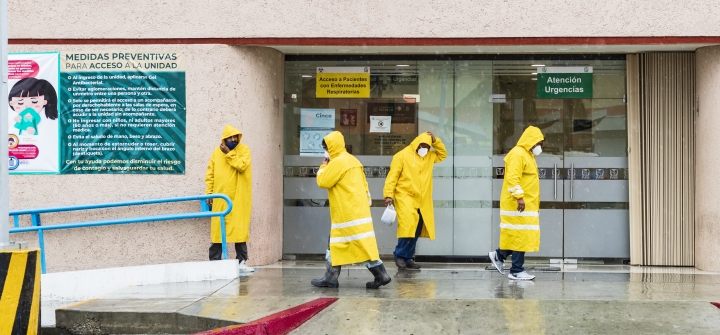‘The Gates of Hell’ Have Opened—Can Health Systems Help Close Them?
“Humanity has opened the gates to hell,” António Guterres told the Climate Ambition Summit Wednesday at the 78th UN General Assembly.
The Summit, hosted by the UN Secretary General, sought to accelerate action on climate change by governments, business, finance, local authorities, and civil society. In an unusual twist, only “first movers and doers” with tangible climate action plans and a high-level speaker were invited to participate. The U.S., China, and India were notably absent from the speakers lists.
Even with the world well behind schedule on current commitments on addressing climate change, Guterres called for developed countries to reach net-zero emissions by 2040—which would push forward current pledges by at least a decade.
Jarbas Barbosa, director of Pan American Health Organization spoke with GHN about how health systems, too, play an essential role in meeting upgraded climate goals—both as a major contributor to emissions and a first responder to climate-related disasters.
What does the impact of climate change look like at the health system level?
A child born in 2020 will experience on average twice as many wildfires, 2.8 times more exposure to crop failures, 2.6 times more droughts, 2.8 times more river flooding, and 6.8 times more heat waves over their lifetime compared to a person born in 1960.
In the PAHO region, in the Caribbean, some countries have had to rebuild their health facilities almost every three or four years (because of extreme weather events.)
In Central America, droughts are impacting the agricultural production, and that is increasing poverty. It is increasing food insecurity and fueling migration.
And nowadays many vectors of communicable diseases are circulating in almost every country in Latin America—and even countries that were relatively protected from them in the past. In Chile, they are now finding the Aedes aegypti mosquito—the vector for dengue, chikungunya, and Zika—in places that didn’t used to have it [due to high altitude].
The most vulnerable populations suffer most from extreme events related to climate change—and that also has huge socioeconomic impacts.
These health effects create massive strain on health systems. How can the health sector play a role in ramping up ambition on climate change?
We really need a strong global commitment to reduce carbon emissions, including with the health sector.
It's estimated that about 4% of global greenhouse gas emissions are produced by the health sector. This is an opportunity to improve the processes and reduce emissions from the health sector.
It’s also essential to develop the early warning systems for climate events so that health systems can quickly and adequately respond to and recover from them.
The vast majority of climate financing goes to mitigation—but funding for adaptation is extremely important for the health sector.
I am also hopeful that climate financing for health will increase so that countries will be able to implement adaptation activities.
What are some examples of what climate ambition looks for health systems?
Many developing countries are raising very important issues related to how to combine climate change response with development and poverty reduction.
For PAHO countries in the Caribbean, the Smart Hospitals Initiative has helped build more resilient hospitals and health centers, and keep them functioning during hurricanes, for instance.
And within PAHO, we are launching a strategy to reduce the greenhouse gas emissions from all the organization's operations to contribute to the global fight against against climate change.
We hope this will encourage other countries to adopt similar programs—not only from ministries of health, but from the overall health sector—which can be a very important element of these more ambitious goals.
Several of the Sustainable Development Goals are related to climate change, and we are not on track to meet them. What’s stopping countries from meeting their goals?
Member states need to overcome all the political divisions and disputes about the causes and the effects of climate change.
It's a challenge because we have a lot of political debate. Things are progressing, but we need more consensus that this is really a global challenge that you need to address together with all the countries coming together to provide the efficient response to the challenge.
It’s important to get more support from the public, legislators, civil society, academic institutions, government, and international organizations to have the recognition of the link between climate change and health—because the health sector also needs to be part of the discussion and part of the solution.
You have an up-close view on how this issue is playing out among world leaders. What gives you hope?
Climate change fortunately has gained significant global attention. In the last 10 years, we’ve moved from a kind of skepticism about climate change to having more governments, people, and organizations recognizing the urgency of the situation. I am hopeful that the health sector also has a seat at the table in climate discussions at the international, regional, and national levels.
I take this as an indication that the health impacts are being recognized, and that the health and well being of populations is being linked to the economic growth of countries.
I'm optimistic because we have progressed. But I am also pessimistic because we don't have two or three decades to reach an agreement, to work together to improve the tools that we already have.
This interview has been edited for length and clarity.
Join the 50,000+ subscribers in 170+ countries who rely on Global Health NOW summaries and exclusive articles for the latest public health news. Sign up for our free weekday newsletter, and please share the link with friends and colleagues.
Maintenance employees of the IMSS hospital in Cabo San Lucas, Mexico, prep for Hurricane Genevieve on August 19, 2020. Alfredo Martinez/Getty Images





